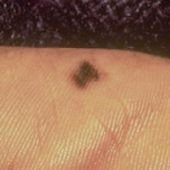You can treat some forms if you notice some damage early. Bowens disease is a cell mutation that’s kind of half way point to cancer. If left untreated it can develop into malignant cancer. I’ve got it and the treatment is a cream that kills off the top skin layer, it’s painful and turns your skin into a big scabby rash but eventually new skin grows back minus the mutation.
There seems to be a defect in either my explanation skills or your comprehension ability. I don’t think it’s the latter, so I will have to lift my game.
No. And further to my last, what seems to confer most risk is the burn/peel/reburn/repeel cycle that some light skinned people suffer, especially in the pre-sunscreen days.
All good my friend. I was just having a joke. Completely understand the point you made. Good analysis
Us darkies have built in protection. Lather up, honkies.
Yes, you have some natural protection, but you shouldn’t get complacent,…
"Though people of color (POC) are less likely to become afflicted with skin cancer, they are much more likely to die from it due to delay in detection or presentation. Very often, skin cancer is diagnosed at a more advanced stage in POC, making treatment difficult. The purpose of this research was to improve awareness regarding skin cancers in people of color by providing recommendations to clinicians and the general public for early detection and photo protection preventive measures".
.
.
.
.
.
___________________________________________________________________________
skincancer.org
Dark Skin Tones and Skin Cancer: What You Need to Know
4-5 minutes
People who have dark skin tones often believe they’re not at risk for skin cancer, but that is a dangerous misconception, says dermatologist Maritza I. Perez, MD, a senior vice president of The Skin Cancer Foundation.
“Anyone can get skin cancer, regardless of race,” she says. While incidence of melanoma is higher in the Caucasian population, a July 2016 study in the Journal of the American Academy of Dermatology showed it is more deadly in people of color. African American patients were most likely to be diagnosed with melanoma in its later stages than any other group in the study, and they also had the worst prognosis and the lowest overall survival rate.
All Skin Types May Be Vulnerable
Most skin cancers are associated with ultraviolet (UV) radiation from the sun or from tanning beds, says Dr. Perez. Yes, darker skin produces more of the pigment called melanin that does help protect skin — but only to a certain extent. People of color can still get sunburned, and they can also develop skin cancer from UV damage.
It’s of concern that 63 percent of African American participants in a survey said they never used sunscreen. This needs to change, says Dr. Perez. “Remember, ethnicity does not define skin type. It can represent a wide range of skin tones with a wide range of risks.” To avoid premature aging and damage that can lead to skin cancer, everyone should use sunscreen every day and practice sun-safe habits, such as seeking shade and wearing protective clothing, hats and UV-blocking sunglasses.
Additionally, certain skin cancers are caused by factors other than UV — such as genetics or environmental influences — and may occur on parts of the body rarely exposed to the sun. For example, people who have dark skin are more susceptible to acral lentiginous melanoma (ALM), an especially dangerous form of melanoma that typically appears on the palms of the hands and soles of the feet. (The Jamaican singer and musician Bob Marley died of ALM when he was only 36.)


People who have dark skin are more susceptible to acral lentiginous melanoma (ALM), like these examples above.
Warning Signs
It’s crucial to detect skin cancer early, when it is easiest to treat and most likely to be cured. Dr. Perez says she advises people of all ethnicities to do a monthly skin self-exam and see a dermatologist annually — and sooner if any of the warning signs appear:
- A bump, patch, sore or growth that bleeds, oozes, crusts, doesn’t heal or lasts longer than a month. This may indicate basal cell carcinoma.
- An ulcer, scaly red patch, wart-like growth or sore that sometimes crusts or bleeds could be a sign of squamous cell carcinoma. This type of skin cancer can also develop in old scars or areas of previous physical trauma or inflammation.
- New or existing moles that are asymmetrical, have an irregular border, more than one color, are larger than a pencil eraser or change in any way may indicate melanoma. Pay special attention to suspicious spots on the hands, soles of the feet or under the nails, which could signify ALM.
Published on August 30, 2016
-
 “We are all susceptible”People of color are not immune to skin cancer. Stacy Jackson, 58, discovered this when his dermatologist informed him he had a basal cell carcinoma (BCC) on the back of his head.
“We are all susceptible”People of color are not immune to skin cancer. Stacy Jackson, 58, discovered this when his dermatologist informed him he had a basal cell carcinoma (BCC) on the back of his head.
Way to burst my bubble.
Better to find out now when you can do something to prevent it than after you get it.
Chrome domes are more susceptible too
Not sorry mate. It’s a myth that needs dispelling.
One of the (too) many friends I’ve lost to this insidious fkn thing was a Koori fella who functioned under this exact misapprehension, as many do.